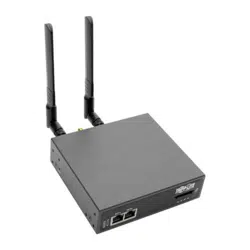Loading ...
Loading ...
Loading ...

181
10. Nagios Integration
Nagios is a powerful and highly configurable open source tool for monitoring network hosts and services. The core Nagios
software package is typically installed on a server or virtual server, the central Nagios server.
Console servers operate in conjunction with a central/upstream Nagios server to provide distributing monitoring of attached
network hosts and serial devices. They embed the NSCA (Nagios Service Checks Acceptor) and NRPE (Nagios Remote Plug-
in Executor) add-ons, allowing them to communicate with the central Nagios server and eliminating the need for a dedicated
secondary Nagios server at remote sites.
Tripp Lite console servers support distributed monitoring. Even if distributed monitoring is not required, the console servers
can be deployed locally alongside the Nagios monitoring host serve, to provide additional diagnostics and points of access to
managed devices.
Note: If you have an existing Nagios deployment, you may wish to use the console server gateways in a distributed monitoring server
capacity only. If this is the case and you are already familiar with Nagios, skip to section 10.3 Advanced Distributed Monitoring
Configuration.
10.1 Nagios Overview
Nagios provides central monitoring of the hosts and services in your distributed network. Nagios is a free, downloadable, open
source software. This section provides a brief overview of Nagios and its capabilities. For a more comprehensive overview, visit
http://www.nagios.org.
10.2 Configuring Nagios Distributed Monitoring
To activate Nagios distributed monitoring on the console server:
• Nagios integration must be enabled and a path established to the central/upstream Nagios server.
• If the console server is to periodically report on Nagios monitored services, the NSCA client embedded in the console server
must be configured in order to enable scheduled check-ins with the remote Nagios server and send passive check results
across the network to the remote server.
• If the Nagios server is to actively request status updates from the console server, the NRPE server embedded in the console
server must be configured with the Nagios daemon for executing plug-ins on remote hosts.
• Each of the serial ports and hosts connected to the console server to be monitored must have Nagios enabled and any
specific Nagios checks configured.
• The central/upstream Nagios monitoring host must be configured.
Loading ...
Loading ...
Loading ...
